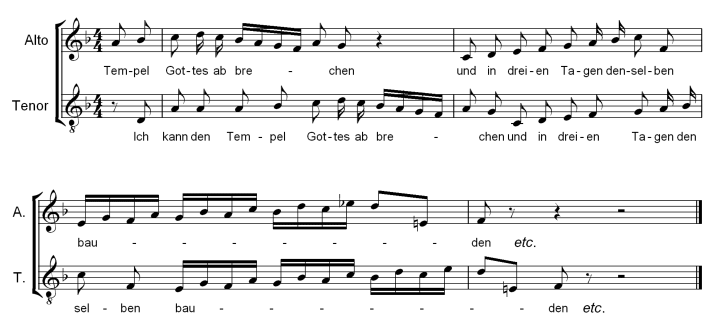The two false witnesses’ reference to the destroying and building of the temple is one of the key arguments against Christ at this “trial” and is referred to later in the work. The music for each of them is identical until the final bar, the second of the two singing his music a little later than the first, generating a musical canon. Bach illustrates the idea of the falling of the temple (abbrechen) with a descending scale, and its rebuilding (bauen) with a rising phrase which goes two notes up and one back down six times, literally creating the picture of steps on the page.

33 |
Evangelist Two False Witnesses Evangelist A High Priest Evangelist |
Und viewohl viel falsche Zeugen herzu traten, funden sie doch keins. Zuletzt traten herzu zween falsche Zeugen und sprachen: “Er hat gesagt: Ich kann den Tempel Gottes abbrechen und in dreien Tagen denselben bauen.” Und der Hohepriester stund auf und sprach zu ihm: “Antwortest du nichts zu dem, das diese wider dich zeugen?” Aber Jesus schwieg stille. |
Yea, though many false witnesses came, yet found they none. At last came two false witnesses, and said: “This fellow said, “I am able to destroy the temple of God and to build it in three days.”.” And the High Priest arose, and said unto him: “Answerest thou nothing? What is it which these witness against thee?” But Jesus held his peace. |
Unlike the other arioso recitatives, this one does not centre on a recurring musical motif. Instead the text is accompanied by heavy, separated chords which are immediately dampened. This is the musical expression of Christ’s silence, whilst his suffering is portrayed in the anguished, lyrical lines given to the tenor.
34 |
Tenor |
Mein Jesus schweigt zu falschen Lügen stille, um uns damit zu zeigen, daß sein Erbarmens voller Wille vor uns zum Leiden sei geneigt, und daß wir in dergleichen Pein ihm sollen ähnlich sein und in Verfolgung stille schweigen. |
My Jesus remains silent in the face of false lies in order to show us that his compassion will bear suffering for us, and that, in similar distress, we should be like him and suffer persecution in silence. |
This aria begins with a short instrumental ritornello in which two separate ideas are given to the cello of orchestra 2. The first, a gentle figure of slurred quaver couplets, contrasts with a much more agitated motif of restless dotted rhythms and wide intervals. These two motifs alternate throughout the aria, each constantly giving way to the other. The first represents calm and patience, the second unease and the stinging of false tongues. For this aria, in which the tenor addresses Christ, Bach dispenses with the orchestra altogether, thereby conveying that Christ is now indeed truly alone.
35 |
Tenor |
Geduld! Geduld! Wenn mich falsche Zungen stechen. Leid ich wider meine Schuld. Schimpf und Spott leid ich Schimpf und Spott. Ei! so mag der liebe Gott meines Herzens Unschuld rächen. Geduld! Geduld! wenn mich falsche Zungen stechen. |
Patience! Patience! When false tongues wound me. I suffer my guilt. I suffer shame and scorn, shame and scorn. Ah! May our dear Lord avenge the innocence of my heart. Patience! Patience! When false tongues wound me. |
Commentary by Peter Parfitt © Aberdeen Bach Choir 2012